I’ve had quite a few embroidery projects going on in the studio this year.
For example, you might remember that we kicked off the year with a voided monogram in floche. And then there was the whitework variation.
There’s been quite a bit of sampling going on this year, too – like this project, and this project, and this project.
There were some new spring towels, and some scroll towels, and some new folk towels.
Here, the Key to my Heart was finished as a hanging sachet and another voided monogram was finished as a needlebook.
Anna finished her Jacobean Bird, and I finished Jacobean Sea.
I started some more miniature stitching, I started (and finished – but I haven’t shown you yet) an ecclesiastical embroidery project, and Anna finished a gold and silk work project, which I have just started and hope to finish soon.
In and out of everything, I’ve worked on my hexie quilt project, too.
And there are a couple other projects still simmering and stewing, which I haven’t shared with you yet.
The reason I’m bring all of this up is because I’ve been asked several times lately a few questions about embroidery frames and hoops. The questions distill down to these general inquiries: What makes you decide to use a hoop over a frame or visa-versa, and should I be using a frame instead of a hoop?
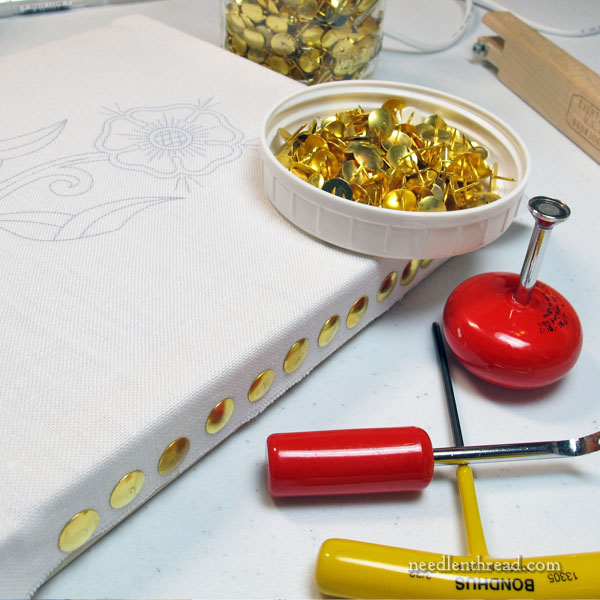
Most of the projects I listed at the beginning of this article involved using an embroidery hoop.
I’ve written gobs about embroidery hoops and frames here on Needle ‘n Thread – and I will link to some of those articles at the end, for your further exploration.
Today, I’m going to talk about when I choose a frame instead of a hoop, and why, along with some incidentals about stretcher bar frames and other types of frames.
You can see in the photo above that I’ve used a pair of stretcher bar frames (specifically, these Evertite Frames – which are my favorites) to frame up the silk and goldwork rose I’m working on.
My Frame-Use Criteria
I use frames – either stretcher bar frames or slate frames (or variations on slate frames) – whenever I’m working on a project that:
1. Will take a while;
2. Fits within the confines of the frame;
3. Involves techniques that require two hands (or that’s easier to work with two hands);
and
4. Involves goldwork or similar techniques that benefit from consistent, even tension throughout the course of the entire project.
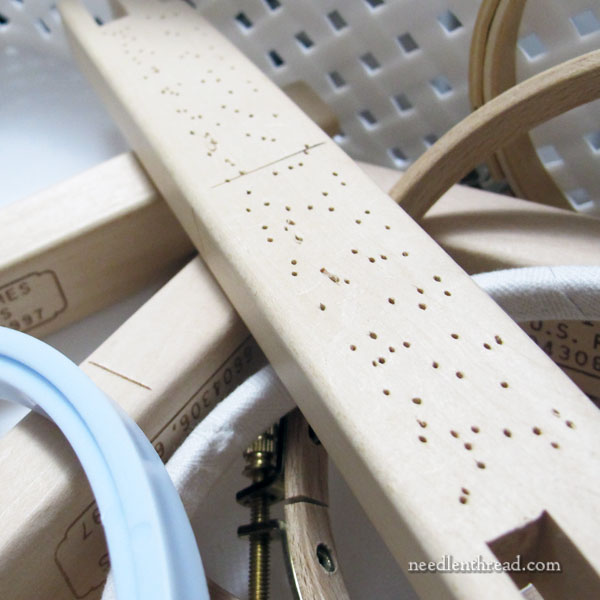
Generally, I use stretcher bar frames more often than slate frames, because I usually work smaller projects. If I were working a large project (something in the 18″ + range in either direction), I’d most likely go for a slate frame or one of its variations.
Why Evertite Stretcher Bars?
But for the most part, when it comes to frames, I use Evertite stretcher bars because:
1. They are quicker to set up than a slate frame;
2. They maintain excellent tension that can be adjusted (unlike plain stretcher bars) with a twist of the inset screws;
and
3. They can be used over and over and over again, so they are a good investment – as evidenced by the stretcher bar shown in the photo above that is riddled with holes from years of use.
Stretcher Bar Essentials
When you use stretcher bars, to make the set-up efficient, it helps to have a few extra tools on hand.
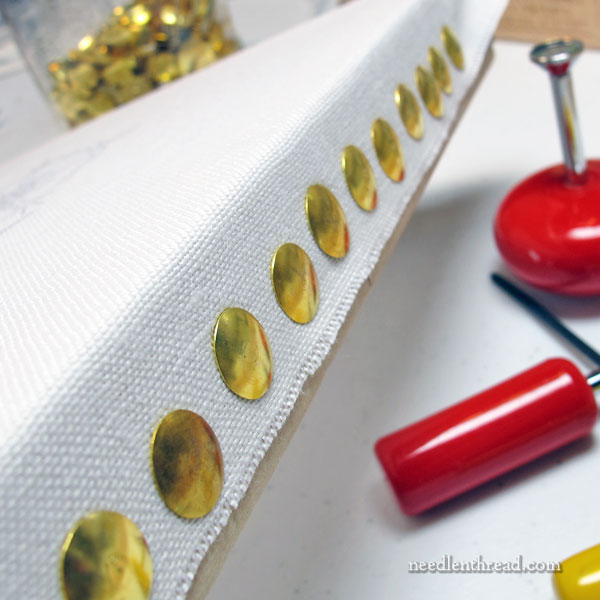
These tools include:
1. An EZE Tack-It Kit – a tool kit available at needlework shops that includes a magnet “pusher” for pushing the tacks into the side of the frame, a puller for removing tacks easily, and some tacks;
2. A jar of tacks;
3. A T-handle allen wrench, for tightening the Evertite frames (not needed if you aren’t using Evertites).
I keep a jar of thumbtacks available, and I use the cheapy ones that you’d find at a hardware store. If they bend or break, I throw them away. I’ve been using the same jar for years and years without replenishing, and although I do lose tacks here and there because of breakage, it is still much more affordable than purchasing the frame tacks sold in small quantities at needlework shops.
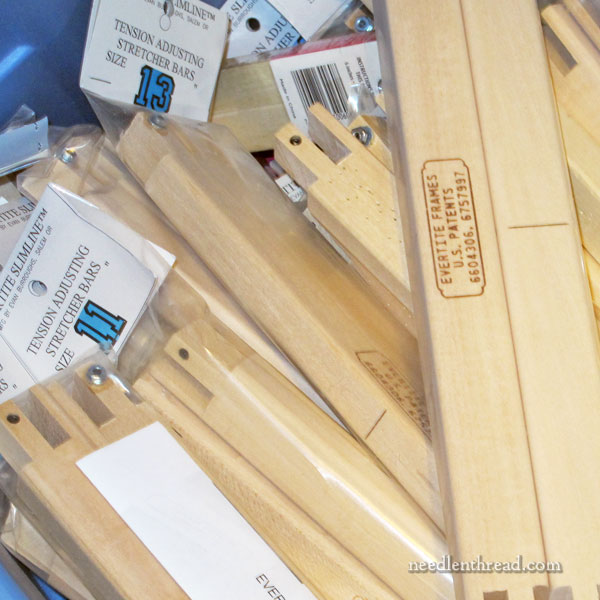
I have a lot of Evertite frames, because I was able to acquire them very affordably from a needlework store that went out of business.
The sizes I find the most useful for my projects range from 8″ through 14″. I commonly use a combinations of 8×8, 9×9, 8×10, 10×12, 10×14, 11×14. I will use stretcher bars up to 20″, but when I project gets beyond that size, I will usually opt for a slate frame, because I can control tension better on larger projects using a slate frame.
I also figure that a larger project will take me longer to stitch, so putting the extra time into the set-up of the project (slate frames take a lot longer to set up) is not as daunting!
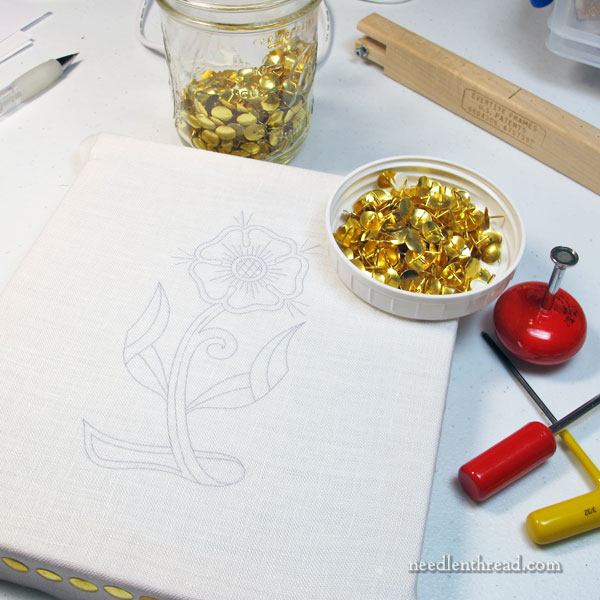
For smaller projects, though, like the silk and goldwork rose above, like Jacobean Sea, like Fantasia in Silk, like the pall design I just finished, and so forth, I really love these stretcher bar frames.
They can’t be beat for quick set-up and for consistently taut fabric.
When I use Hoops
I use hoops for regular surface embroidery, when I need to be able to move the hoop around the design.
I also use hoops for very small, quicker projects that fit within the perimeter of a small 4 or 5″ hoop.
So, for the voided monograms earlier this year, for these snowflake ornament designs from last Christmas, for projects like the Twelve Trees for Christmas, and for all the towel sets I’ve embroidered and all the smaller sample projects that have shown up here on the website over the years, a small hoop is perfect.
More on Hoops & Frames
If you want to read more about embroidery hoops and frames, check out these articles:
Embroidery Hoop or Frame? – This covers a lot of information about embroidery hoops and different types of frames.
The Embroidery Hoop – what makes a good one?
Binding an Embroidery Hoop – why and how to bind the inner ring of an embroidery hoop
Evertite Stretch Bars – Review and How to Use Them
A Hoop on a Stick – embroidery hoop sit-on stand
Dressing a Slate Frame for Hand Embroidery – a tutorial for setting up a huge slate frame
Solid and Serviceable Slate Frames – a review of excellent slate frames from Access Commodities
You can also read about all kinds of other needlework tools by visiting this topic on Needle ‘n Thread.







In 2019 I read your articles on embroidery hoops and decided to get a Klass & gessman hoop but sadly they are no longer made by Klass & gessman now, name is now Mein Hobby and not worth the money now, terrible quality the inner and outer hoop don’t match up and screw section breaks if you tighten it. They sold the Business to a new owner about 2018..
Hi, Jess – I think there was a kerfuffle in manufacturing back in 2018, but I do believe they are back in business now.
Slightly off topic – but about the last pic in this post – I just noticed, the rose looks like it’s looking out at you and waving or conducting an orchestra, or something like that. I know “cute” isn’t the goal of most goldwork, but today your rose makes a cute cartoon character!
Dear Mary
Thanks for the advice on hoops Vs frames. I agree with you that it’s easier to use a frame on long term projects and bigger designs especially if you need to use two hands. A hoop is easier for smaller projects and for turning as you embroider. I wish Evertite stretcher frames were available in the UK but they are not and shipping is so expensive these days, I will look out for an alternative. Thank you for sharing with us your advice on when to use a frame and when to use a hoop and for the links above. I look forward to your progress on the silk an goldwork rose above.
Regards Anita Simmance
Dear Ms Corbet,
Thank you for your detailed and informative article about frames and hoops. As always, your cheerful style and clear competence is so refreshing!
I am wondering if you have revised your opinion of the Millennium frames? You wrote earlier that they were wonderful: very easy to set up, kept your fabric taut, were lightweight and easy to handle. Have you found problems with them (other than their ofttimes difficulty with stock/availability)?
Thank you,
laura
I love the millennium frame! I still use it when I have a need for it. But lately, I’ve been working smaller projects, and stretcher bars are fine for those. The difficulty with the millennium frame is still ordering it – it takes a while to arrive – but they have apparently gotten much better about that!
Why yes, I am working my way through some articles. I am collecting your pieces on silk threads, and a few other things that caught my eye.
Are these frames actually for embroiderers, or are they primarily for painters? The look more like “artist frames.
What’s your take on scroll bars?
Regards, Susan
Stretcher bar frames for needlework are made for the needlework industry. Canvas stretchers for artists’ canvas are usually flatter and wider. Most needlework stretcher bars are square-er, and around 3/4″ – 1″ square, as far as the wood goes. I am not 100% fond of scroll bars, because they lack side tension. That said, you can always add side tension by lacing the sides like you would with a slate frame.
Great post! Thank you so much for giving examples of projects that would work best for the hoop and for the frame. Your point comparing techniques that would be best supported by a frame, like goldwork due to the need for consistent tension over time, or techniques that use both hands simultaneously vs techniques that would do best with a hoop, like a stitch that would benefit from your ability to rotate the piece while you work, was extremely helpful. I’ve been wondering if I should buy a frame as I get back into embroidery as an adult, and this article has helped me with that decision tremendously; what I’m working on and planning out now doesn’t need it, so I can save my money (yay).
Hello!
I just love reading your posts .. thank you.
Regarding slate frames… I need to go back further even than you have discussed… could you tell me why they are called “ slate” frames?
I’m sure you can tell I’m a very beginning beginner?
Best regards,
Martha
There’s all kinds of surmises on why they’re called that, but nothing definitive. Some say it’s a spelling derivative of “slat” (based on the use of side slats – and that wouldn’t be too unbelievable or unusual, because spelling certainly wasn’t codified in the early days of slate frames). Some people say it’s because they look, in shape, like old school slates (the frame of the school slate without the slate in it)… but…? I don’t find that too convincing. Were school slates called slates? Were they in common usage during the early days of the slate frame? I’d have to see some research on that one.
I even read once where someone said, off hand as if it were common knowledge, that embroidery frames used to be made from slate, and that’s why they’re called slate frame – but there is absolutely no proof of this anywhere, and it is highly unlikely and a rather silly statement. Slate would not be a reasonable material for making embroidery frames, especially when wood was abundant and easy to work, and slate required serious labor to acquire, it was heavy, and it is not of the right make-up to function as an embroidery frame.
Lots of people speculate or put forth theories without definite research to back them up.
I tend to think the most feasible explanation is the spelling derivation, due to un-codified spelling rules. But who knows?
Where can I buy your evertight frames in England?
Hi, Mary – I don’t know of a source for Evertite frames in the UK. There are some shops here in the US that carry them, that will ship to the UK. I recommend checking Needle in a Haystack.